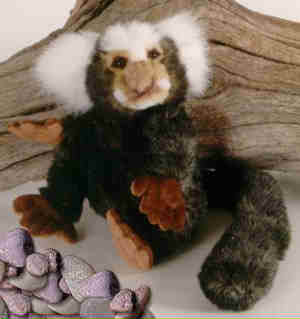|
|
You and your children will have hours
of Delightful Entertainment as you play with
these Amazing Plush Stuffed Marmoset Monkeys.

Luxuriously Soft plush stuffed Marmoset Monkey
toy animals of the finest quality are so
Unique and Cool to have.
Give the gift of an amusing stuffed Marmoset Monkey
to that special person in your life.....
and watch them light up like a Christmas Tree
Simply Adorable and easy to make friends With.
Stuffed plush Marmoset Monkey
click on the Stuffed Ark banner here:

Delightful Marmoset Monkey Calendars
Marmoset Monkeys are so Cool
Marmosets are found in the wild in Central and South America
and consist of around eighteen species. The name Marmoset is
in reference to the Goeldi's Marmoset, scientifically known
as Callimico Goeldii. While commonly identified as monkeys,
strictly speaking, they are not. They are primates, however.
Marmosets are usually around twenty centimeters long and
look generally like small monkeys. They do not have a set of
wisdom teeth and they have a rather primitive brain. They
have claws and tactile hairs on their wrists. Their relative
body temperature can change up to seven degrees Fahrenheit
during the day and varies greatly.
Marmosets live in the upper canopy of the rain forests and
are very active. They eat mostly fruit, leaves and insects.
They have long lower incisors which allow them to chew holes
in the tree trunks to eat the gum on the inside of trees.
Some species specialize on feeding on the gum on the inside
of trees.
Marmosets live in family groups numbering between three to
fifteen animals. The groups are usually made up of one to
two breeding age females and an unrelated male Marmoset. The
offspring from the unions can also be a part of the family
group and possibly some unrelated individuals.
The mating relationships in Marmosets are variable and can
include monogamy, polygamy and sometimes polyandry. In most
species of Marmoset the mating results in fraternal twins or
sometimes triplets. Marmosets will raise their young
cooperatively usually and some food sharing and stealing of
food by the young is tolerated.
Every animal in the family group that is older than the
babies take a turn carrying them around. Marmosets are
believed to be territorial and they do mark their territory
through scent markings. They will defend their territory
when they feel that it is being threatened. The reason why
it isn't understood how territorial they are is because the
differing Marmoset family groups often have territory that
overlaps one another.
According to research, Marmosets exhibit germline chimerism,
which is not known to occur in nature in any other primate.
Germline chimerism is when the germ cells (for example,
sperm and egg cells) of an organism are not genetically
identical to its own. It has recently been discovered that
marmosets can carry the reproductive cells of their
(fraternal) twin siblings, because of placental fusion
during development. (Marmosets almost always give birth to
fraternal twins. - www.wikipedia.com )
As an aside, the Marmoset is mentioned in "The Tempest" (Act
2, Scene 2), by Shakespeare, when Caliban says that he will
instruct his new master Stephano "how to snare the nimble
Marmoset" [for eating], on the no-man island on which the
play takes place.
|